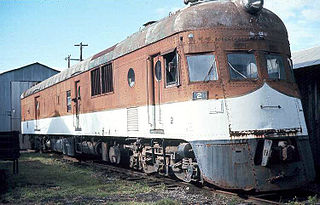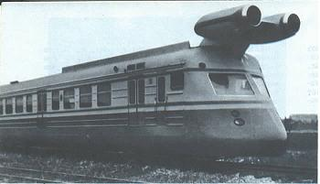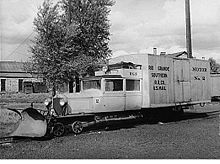
A railcar is a self-propelled railway vehicle designed to transport passengers. The term "railcar" is usually used in reference to a train consisting of a single coach, with a driver's cab at one or both ends. Some railway companies, such as the Great Western, termed such vehicles "railmotors".

A diesel locomotive is a type of railway locomotive in which the power source is a diesel engine. Several types of diesel locomotives have been developed, differing mainly in the means by which mechanical power is conveyed to the driving wheels. The most common are diesel-electric locomotives and diesel-hydraulic.

A streamliner is a vehicle incorporating streamlining in a shape providing reduced air resistance. The term is applied to high-speed railway trainsets of the 1930s to 1950s, and to their successor "bullet trains". Less commonly, the term is applied to fully faired upright and recumbent bicycles. As part of the Streamline Moderne trend, the term was applied to passenger cars, trucks, and other types of light-, medium-, or heavy-duty vehicles, but now vehicle streamlining is so prevalent that it is not an outstanding characteristic. In land speed racing, it is a term applied to the long, slender, custom built, high-speed vehicles with enclosed wheels.

The McKeen Motor Car Company of Omaha, Nebraska, was a builder of internal combustion-engined railroad motor cars (railcars), constructing 152 between 1905 and 1917. Founded by William McKeen, the Union Pacific Railroad's Superintendent of Motive Power and Machinery, the company was essentially an offshoot of the Union Pacific and the first cars were constructed by the UP before McKeen leased shop space in the UP's Omaha Shops in Omaha, Nebraska. The UP had asked him to develop a way of running small passenger trains more economically and McKeen produced a design that was ahead of its time. Unfortunately, internal combustion engine technology was not and the McKeen cars never found a truly reliable powerplant.
The St. Louis Car Company was a major United States manufacturer of railroad passenger cars, streetcars, interurbans, trolleybuses and locomotives that existed from 1887 to 1974, based in St. Louis, Missouri.

The Budd Company was a 20th-century metal fabricator, a major supplier of body components to the automobile industry, and a manufacturer of stainless steel passenger rail cars, airframes, missile and space vehicles, and various defense products.

The St. Louis–San Francisco Railway, commonly known as the "Frisco", was a railroad that operated in the Midwest and South Central United States from 1876 to November 21, 1980. At the end of 1970, it operated 4,547 miles (7,318 km) of road on 6,574 miles (10,580 km) of track, not including subsidiaries Quanah, Acme and Pacific Railway and the Alabama, Tennessee and Northern Railroad; that year, it reported 12,795 million ton-miles of revenue freight and no passengers. It was purchased and absorbed into the Burlington Northern Railroad in 1980. Despite its name, it never came close to San Francisco.

The Budd Rail Diesel Car (RDC), also known as the Budd car or Buddliner, is a self-propelled diesel multiple unit (DMU) railcar. Between 1949 and 1962, 398 RDCs were built by the Budd Company of Philadelphia, Pennsylvania, United States. The cars were primarily adopted for passenger service in rural areas with low traffic density or in short-haul commuter service, and were less expensive to operate in this context than a traditional diesel locomotive-drawn train with coaches. The cars could be used singly or coupled together in train sets and controlled from the cab of the front unit. The RDC was one of the few DMU trains to achieve commercial success in North America. RDC trains were an early example of self-contained diesel multiple unit trains, an arrangement now in common use by railways all over the world.

The Pioneer Zephyr is a diesel-powered trainset built by the Budd Company in 1934 for the Chicago, Burlington & Quincy Railroad (CB&Q), commonly known as the Burlington Route. The trainset was the second internal combustion-powered streamliner built for mainline service in the United States, the first such train powered by a diesel engine, and the first to enter revenue service.

The J. G. Brill Company manufactured streetcars, interurban coaches, motor buses, trolleybuses and railroad cars in the United States for nearly 90 years, hence the longest-lasting trolley and interurban manufacturer. At its height, Brill was the largest manufacturer of streetcars and interurban cars in the US and produced more streetcars, interurbans and gas-electric cars than any other manufacturer, building more than 45,000 streetcars alone.

Galloping Goose is the popular name given to a series of seven railcars, built in the 1930s by the Rio Grande Southern Railroad (RGS) and operated until the end of service on the line in the early 1950s. They were derived from full-sized automobiles.

The Ghost Town & Calico Railway is a 3 ft narrow-gauge heritage railroad and amusement park attraction within Knott's Berry Farm, an amusement park located in Buena Park, California.

The Rio Grande Southern Railroad was a 3 ft (914 mm) narrow-gauge railroad which ran in the southwestern region of the US state of Colorado, from the towns of Durango to Ridgway, routed via Lizard Head Pass. Built by German immigrant and Colorado toll road builder Otto Mears, the RGS operated from 1891 through 1951 and was built with the intent to transport immense amounts of silver mineral traffic that were being produced by the mining communities of Rico and Telluride. On both ends of the railroad, there were interchanges with The Denver and Rio Grande Railroad, which would ship the traffic the RGS hauled elsewhere like the San Juan Smelter in Durango.

The OP800 was a lightweight, streamlined railcar built by the St. Louis Car Company in 1939. Fairbanks-Morse supplied the 800 hp (600 kW), five-cylinder 8 in × 10 in opposed piston engine prime mover. The units were configured in a highly unusual 2-A1A wheel arrangement (later converted to 3-A1A) mounted atop a pair of road trucks, and equipped with a front swing coupler pilot. The aft section was divided into two separate compartments: one was used to transport baggage and the other served as a small railway post office, or RPO.

The Pioneer III railcar was a short/medium-distance coach designed and built by the Budd Company in 1956 with an emphasis on weight savings. A single prototype was built, but declines in rail passenger traffic resulted in a lack of orders so Budd re-designed the concept as an electric multiple unit (m.u.). Six of the EMU coach design were purchased by the Pennsylvania Railroad with the intention of using them as a high-speed self-contained coach that could be used for long-distance commuter or short-distance intercity travel in the Northeast U.S. The 6 production Pioneer III units were the first all-stainless-steel-bodied EMU railcar built in North America and, at 90,000 pounds (41,000 kg), the lightest.

A turbojet train is a train powered by turbojet engines. Like a jet aircraft, but unlike a gas turbine locomotive, the train is propelled by the jet thrust of the engines, rather than by its wheels. Only a handful of jet-powered trains have been built, for experimental research in high-speed rail.

The Roger Williams was a six-car streamlined lightweight DMU passenger train built by the Budd Company in 1956 for the New York, New Haven and Hartford Railroad. The train was based on Budd's successful RDC DMU cars. The end two cars were equipped with streamlined locomotive style cabs and noses, resembling those on the Fairbanks-Morse P-12-42 Diesel locomotives. The four intermediate cars lacked operating controls and cabs.
The Doodlebug disaster was a railway accident that occurred on July 31, 1940, in Cuyahoga Falls, Ohio, in the United States. A Pennsylvania Railroad, gasoline-powered "doodlebug" passenger rail car collided head-on with a freight train; the impact and resulting fire caused the deaths of all but three of the 46 onboard.

Rio Grande Southern Railroad (RGS), Motor No. 2 is a gasoline engine-powered narrow gauge railroad motorcar. It was converted on August 12, 1931 from a 1927 Buick Master Six 4-door sedan in a conversion known as a Galloping Goose. The Buick was cut behind the rear doorpost and extended with sheet metal 18 inches (46 cm) to form an enlarged passenger compartment. With no functional use, the steering column was removed. The couch from the RGS office become the back seat as it is shown being requisitioned for Goose No. 2 on the statement covering construction. The front axle was removed and replaced with a swiveling, two-axle lightweight railroad truck with 16 in (41 cm)-diameter wheels that carried and guided the front of the Goose. Ahead of the front truck the pilot is attached to the frame. There were two small pivoted scrapers attached to the rear of the pilot to keep small objects on the track from derailing the lightweight front truck. During the winter season a small snowplow was attached to the front of the pilot.

Rio Grande Southern Railroad (RGS), Motor Number 6 is a gasoline engine powered narrow gauge railroad motor car. The Galloping Goose body and chassis were built from a Buick automobile. The new Buick body was cut off behind the front seat and a new rear wall installed. The steering wheel was removed as it was not needed, but the other controls remained. The front axle was removed and replaced with a swiveling two axle lightweight railroad truck with sixteen inch diameter wheels that carried and guided the front of the Goose. Ahead of the front truck is the pilot attached to the frame. Two small pivoted scrapers attached to the rear of the pilot slide on the rails to keep small objects on the track from derailing the lightweight front truck. During the winter season a small snow plow was attached to the front of the pilot. The rear of the car frame was lengthened using steel channel riveted together but welded to the frame to carry the truck type flat-bed platform. The bed has short stake racks around the sides to keep materials from falling off. The Goose was originally powered by the 6-cylinder engine, clutch and transmission that came with the Buick. The drive chain powers the rear swiveling two axle truck assembly mounted under the rear frame and platform bed. The drive shaft turns only the forward axle. The rearmost axle is driven by roller chains and sprockets mounted outside of the wheels on each side. The rear truck has twenty four-inch diameter cast wheels. The braking is accomplished by brake shoes between the axles on each truck being pushed against the wheel treads. These are actuated by linkage connecting them to the normal foot pedal and parking brake lever. The foot brake is connected to the front truck and the parking brake lever is connected to the rear truck. Goose No. 6 received air brakes about 1939. The paint colors of Goose No. 6 early on is still an item of much discussion. Examination of the paint layers on the rear bed revealed only black and then aluminum that was used after 1935.




















